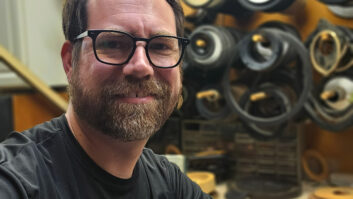When Puls CEO Eyal Ronen and president Itai Hirsch started discussing the idea for the company they co-founded three and a half years ago, the pitch was very simple: “Can we fix the repair industry?”
“The vision was that we’d like to bring the technician to your house, within one hour, for whatever you need,” Ronen explained. “It can be for your washing machine, for fixing your iPhone, for installing your cool new smart home [devices], or that fancy TV you just bought. It’s a very big problem globally. It helps everyone from insurance companies that have to fix your home appliances to manufacturers that don’t have solutions for service across the U.S.—just to a lot of local technicians with no certifications and no ability to acquire parts with the right quality.”

After self-funding the company for the first nine months and developing key manufacturer service agreements from major brands like Google and Samsung, the company now boasts more than 2,000 technicians, in over 50 markets across the U.S. Only the best technicians are accepted as freelancers for the company, but each is trained in the services and products that Puls supports and each is given free tools, spare parts, logos, and t-shirts, and access to an Uber-style app for responding to calls.
Initially, the company serviced only mobile devices.
“We chose this category for two very specific reasons,” Ronen explained. “One, it’s the most urgent device to fix because we have a lot of dependency on it. And, two, the logistics behind making these repairs is easier because you can carry hundreds of parts in your backback, compared with, say, needing a van to carry a part for repairing an air conditioner.”

The Puls founders also made the strategic decision to “own the entire ecosystem,” end to end, apart from the technician himself.
The customer communicates with Puls and pays Puls. Puls handles all of the scheduling and supplies all of the spare parts needed for a repair (for free to the technician), and supplies all of the tools for the technicians. In addition, Puls encourages its technicians to learn new services, such as the latest one for the Google Pixel device. The technicians are freelancers, so they only handle the repair itself, receiving a flat fee (between $35 and $65, depending on the type of service) every time they complete the repair or installation. The technician never has to field the customer’s initial call, deal with marketing, or handle billing issues. All of that is taken care of by Puls.
“We just offer them the opportunity to take a service [call] on a daily basis,” Ronen said. “By doing that, we manage to completely reduce the friction between the technician and the customer. No more haggling on price. No more discussions of who pays what. By doing that, the entire process is much more seamless for both technicians and customers.”

Following their self-financed nine-month start-up phase, the Puls founders brought in Sequoia Capital as a venture capital investor for its seed round of financing. For the first year and half, the company continued servicing only mobile devices, but then expanded into tablets, smart watches, and similar products, as the company grew. At the beginning of 2017, Puls was named the official service provider for Google in-home services in the U.S.
“If you go to the Google website right now and search for ‘How do I fix by Google Pixel device?’ Puls will be offered as the official repair company,” Ronen said. “One of the things that is very important for Google and for us is making sure our customers are happy and our technicians are happy. We measure this with very specific tools.”
One measurement tool used by Puls is the Net Promoter Score [NPS]. According to Ronen, Puls has a net NPS score of 78 every day, which he said is unheard of for a service company. “Mainly because people are delighted that we actually got to them in less than an hour and fixed the device on the spot, in front of them, without them moving from their desk or their couch,” he noted.
Puls continues to expand its services beyond phone repair, into TVs, smart homes, security systems, and antennas. Eventually it will move into other verticals, including appliance repair, garage doors, and PC support.
“By doing this, we believe that we are going to cover all of the electronics in your house, and everything that is connected to an outlet apart from your lighting,” Ronen said. “The new verticals grew very quickly and now account for almost 50 percent of our revenues.”
The company is growing not only by adding services and devices, but also by expanding into new markets in the U.S. and adding more qualified technicians.

Puls built the proprietary technology that allows it match service a service request to its qualified service technicians. “That’s at the basis of everything that we do,” Ronen said.
Ronen said that unlike Uber, matching a service request with a technician is much more complicated. “Think about yourself trying to take an Uber,” he said, “if the car has to be red and the name of the driver has to be David; it complicates the entire system. So we have 26 of those types of parameters because your iPhone 6 might be black and my iPhone 6 might be white, and you need a speaker fixed and I need my TV to be mounted. More than that, not every technician will carry each piece of inventory. And not every technician will have the same skills. Obviously they’re also not located in the same places. We keep in mind two parameters. One is the real-time data (you’re over there, I’m over here, these are the parts I have on me, and these are my skills) and beyond that are the things we call the long-term metadata, which traffic in San Francisco. Does it make more sense to go into San Francisco from Walnut Creek or Palo Alto?”
The Puls system will identify, in less than half a second, the five technicians that are most suitable to take a specific repair. All of them will be notified, and the system already knows that they have the proper repair parts with them because they got them at the beginning of the week. Each technician also knows how much money they will make on the job, so they can make a decision about whether or not they want to take the job. For instance, one tech might know that he can earn $40 for a 20-minute drive to fix an iPhone 7 or $80 to install a full smart home after driving for an hour. The app also tells the technician what they would made if they had said “yes” to every offer Puls gave them in a given month. Top-level technicians in the company can easily make more than $55,000 a year, according to the Ronen.

As the company looks ahead, Ronen sees his company becoming a trusted advisor for clients. “It’s about, ‘How do I choose a device, how do I set up a device, and how do I use a device on a daily basis?’ That’s where we see market going. It’s about the product experience, rather than just buying the product from someone. The product itself is a commodity. We want to be a single focal point for the end user to ask advice on what products or technologies to buy.”
Puls was founded in San Francisco, but its top three markets are Los Angeles, New York City, and Dallas, followed by Phoenix, San Francisco, Houston, and Austin. To determine whether or not to enter a new market, Puls performs what it calls its “smoke test.” The company launches a nationwide TV ad campaign and monitors where the most demand is coming from. Those who request service out of cities where Puls offers no support, are given a polite “we’re sorry,” but it will allow the company to measure the amount of demand its sees from those cities.
Service partnerships through companies such as Google and Samsung SmartThings also help drive demand into new markets. “We have committed to some of our partners that by the end of 2019, we are going to cover more than 80 percent of the U.S. population,” Ronen said. “That’s only possible through our partnerships, which basically deliver our demand for us.”
Maybe you’re wondering how you can work for Puls? The brand advertises on Craig’s List, Indeed, and Facebook, but more than 25 percent of its applicants come through referrals from other technicians. But the company doesn’t accept just anyone.
“We now have an 8.5 percent on-boarding success, meaning that out of 100 applicants, we will bring on only 8.5,” Ronen said. “Usually we want people with a lot of experience. We don’t want university student that just completed five repairs for his friends. But we do want to find professionals. The skilled technicians that have done this many many times before. They all go through a background check and they all go through a technical test. The last piece is a conversation with the engagement team as a compatibility test. In the end, it’s the technicians that are going to represent the company and maybe doing some upselling in the house. At 8.5, we’re getting the best of the best. Just to give you sense, we interviewed more than 30,000 technicians so far, in different levels to get to our couple of thousands of technicians we have now.”







